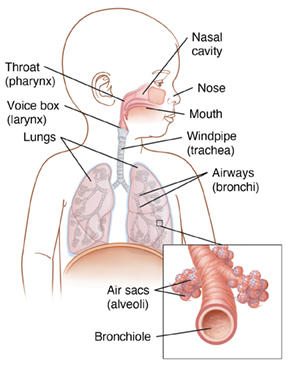A
B
C
D
E
F
G
H
I
J
K
L
M
N
O
P
Q
R
S
T
U
V
W
X
Y
Z
Topic IndexLibrary Index
Click a letter to see a list of conditions beginning with that letter.
Click 'Topic Index' to return to the index for the current topic.
Click 'Library Index' to return to the listing of all topics.
The Respiratory System in Babies
What is respiration?
Respiration is the act of breathing in and out. When you breathe in, you take in oxygen. When you breathe out, you give off carbon dioxide.
What makes up the respiratory system?

The respiratory system is made up of the organs that take part in gas exchange:
-
Nose
-
Mouth
-
Throat (pharynx)
-
Voice box (larynx)
-
Windpipe (trachea)
-
Airways (bronchi)
-
Lungs
The upper respiratory tract includes the:
The lower respiratory tract includes the:
-
Voice box
-
Windpipe
-
Lungs
-
Airways (bronchi)
-
Air sacs (alveoli)
What do the lungs do?
The lungs take in oxygen. The body's cells need oxygen to live and carry out their normal functions. They also get rid of carbon dioxide. This is a waste product of the cells.
The lungs are 2 cone-shaped organs. They're made up of spongy, pinkish-gray tissue. They take up most of the space in the chest, or the thorax (the part of the body between the base of the neck and diaphragm). They're inside a membrane called the pleura.
The lungs are separated by an area (mediastinum) that has:
The right lung has 3 lobes. The left lung has 2 lobes. When you breathe, the air:
-
Enters the body through the nose or mouth
-
Travels down the throat through the voice box and windpipe
-
Goes into the lungs through tubes (mainstem bronchi):
-
One of these tubes goes to the right lung and 1 goes to the left lung
-
In the lungs, these tubes divide into smaller bronchi
-
Then into even smaller tubes called bronchioles
-
Bronchioles end in tiny air sacs called alveoli
Breathing in babies
An important part of a baby's lung development is the production of surfactant. This is a substance made by the cells in the small airways. By about 35 weeks of pregnancy, most babies have developed enough surfactant. It's normally released into the lung tissues. There it helps to keep the air sacs open. Premature babies may not have enough surfactant in their lungs. They may have trouble breathing.
Online Medical Reviewer:
Stacey Wojcik MBA BSN RN
Date Last Reviewed:
3/1/2024
© 2000-2025 The StayWell Company, LLC. All rights reserved. This information is not intended as a substitute for professional medical care. Always follow your healthcare professional's instructions.